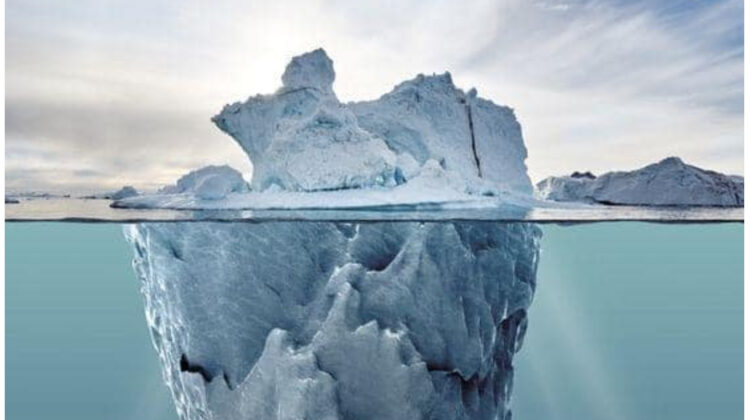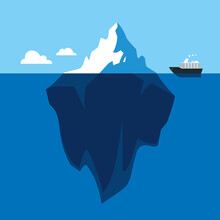
Today I channeled my energy into this very unofficial but passionate petition for scientists to start drawing icebergs in their stable orientations. I went to the trouble of painting a stable iceberg with my watercolors, so plz hear me out.
— Megan Thompson-Munson (@GlacialMeg) February 19, 2021
(1/4) pic.twitter.com/rtkCYub38b
Megan Thompson-Munson’s watercolor painting of an iceberg in a stable position. Source: @GlacialMeg via Twitter
Consider an iceberg floating in the sea. Most people imagine a tall, pointy chunk of ice with a large hidden section beneath it. While it is true that only 10% of an iceberg is visible above the water’s surface, popular portrayals of icebergs are frequently inaccurate, because any elongated iceberg will float with its long axis parallel to the water’s surface — on its side, as opposed to the usual pictures we see. More people are becoming aware of this icy reality as a result of a viral tweet and an interactive website.
Megan Thompson-Munson, a PhD student at the University of Colorado Boulder studying the interactions between ice sheets and changing climate, was looking for a way to combine her newfound pandemic hobby, watercolor painting, and her research. Her research informed her that as the climate changes, the melting of glaciers and ice sheets accelerates, and there is an increase in icebergs calving, or breaking off of, ice sheets or glaciers. Massive amounts of ice calve off into the ocean when coastal glaciers flow.


When Thompson-Munson searched for images of icebergs to use as inspiration for her watercolor paintings, she discovered that they did not resemble the icebergs she had seen in her own research. “I found myself staring at a screen full of drawings and paintings of icebergs in perilous positions,” she explained to GlacierHub. “When I set out to draw my own iceberg, I realized that all of these were incorrect and that I needed to draw it differently.”
Josh Tauberer, a software developer and civic technologist, created an interactive website the next day where people can draw their own hypothetical iceberg and see how it would float in the ocean. “After reading the thread on the tweet, I discovered a really simple mathematical explanation for the underlying principle of how an iceberg floats,” he explained. “I combined this with my knowledge of scientific computing and created Iceberger, a web app.” Soon after, Iceberger Remixed was created, allowing users to select preset shapes and see how melting affects the icebergs.
Thompson-Twitter Munson’s thread included a popular article by Henry Pollack, an emeritus professor of geophysics at the University of Michigan, explaining why icebergs float horizontally rather than vertically. The scientific explanation for why an iceberg will float on its side is a simple interaction of two forces, gravity and the buoyancy of water.
“The key thing to understand is the alignment between gravity’s force pulling the iceberg down at its center of gravity and the buoyancy of the water pushing up on the iceberg,” Tauberer explained. “If the iceberg is not symmetrical, meaning the center point of the iceberg is a little to the left or right, the iceberg will rotate until equilibrium is established between the center of the iceberg’s gravity and the buoyancy force.”
While most people will never have the chance to see massive icebergs floating in the Earth’s polar regions, there are a few other ways to visualize them at home. “In addition to the Iceberger website, I’ve suggested to people that they can put an ice cube or a cork from a wine bottle in water and see if they float on their side,” Thompson-Munson told GlacierHub.
Megan Thompson-artistic Munson’s tweet, as well as the interactive web apps inspired by it, demonstrate art’s ability to challenge popular misconceptions about scientific principles. Communication has become more important than ever as scientific understanding has become more important as we face the climate crisis.
Thompson-Munson communicated with other scientists about scientific misconceptions beyond iceberg stability after her tweet went viral. “One of the cool things about this tweet is that people have reached out with misconceptions in their own scientific fields and suggested that I paint them as well. While I may not have the time to do this myself, I believe it is critical that these discussions begin.”

Leave a Reply